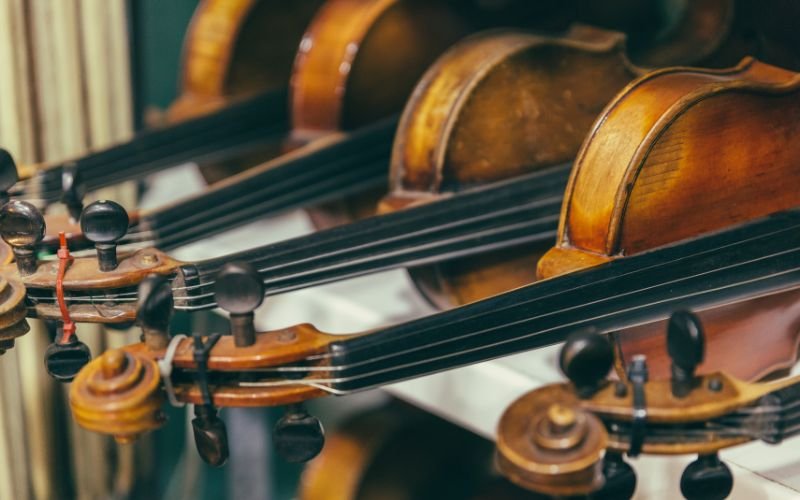First violin: our advice on choosing the right instrument
Are you about to choose a violin, but feel a little lost in the jungle of available options? Don't panic! Whether you're a beginner, a seasoned musician or your child's first instrument, Newzik can help you find the violin that's right for you. Acoustic or electric violin? What are the differences between a 4/4 or 3/4 violin? How do you choose a violin to suit your child's age or even playing style? To find the violin of your dreams, follow the guide!
Violin sizes, from 1/16 to 4/4
Each violin size is designed to adapt to the musician's morphology and age. Here's an overview of possible violin sizes to guide you in your choice:
1/16: this is the smallest violin available, ideal for initiating toddlers from age 3. Lightweight and suitable for very short arms, it allows young children to discover posture and basic gestures without tension.
1/10: This violin is perfect for children aged 4 to 5, with a suitable arm length. Larger than the 1/16, it's still light and easy to handle, making it ideal for early learning.
1/8: suitable for children aged around 5 to 6, the 1/8 violin offers a slightly larger size for better finger control and greater freedom of movement. A good choice for children who show an interest in the instrument.
1/4: Recommended for children aged 6 to 7, this violin is both comfortable to play and large enough to offer good finger positioning. It is also often the choice for young beginners starting more regular music lessons.
1/2: Ideal for children aged 7 to 9, this intermediate-sized violin enables more advanced progress. It offers children a better mastery of playing techniques, while remaining light and easy to handle.
3/4: this size is generally intended for pre-adolescents aged 9 to 12, or for musicians of smaller stature. The 3/4 violin is often a stepping stone to the 4/4 for teenagers, and already allows for richer musical expression.
4/4: the full-size violin for teenagers and adults. This is the standard size for experienced violinists, offering optimal resonance and richness of sound. Once up to this size, the musician can explore all the nuances and techniques of the violin without size limits.
| Violin size | Approximate age |
|---|---|
| 1/16 | 3-4 years |
| 1/10 | 4-5 years |
| 1/8 | 5-6 years |
| 1/4 | 6-7 years |
| 1/2 | 7-9 years |
| 3/4 | 9-12 years |
| 4/4 | Teens and adults |
How to choose the right violin size?
To check whether a violin fits you (or your child), all you need to do is perform a simple test. Place the violin on your left shoulder, then extend your left arm to grasp the fingerboard with your hand. You should be able to reach the end easily, without having to stretch your arm too far. A well-adjusted violin not only ensures better note control, but also prevents muscular tension, especially in young musicians.
Acoustic violin: the traditional choice
The acoustic violin is often a violinist's first love. Its rich, enveloping sound is due to its wooden resonance box, which naturally amplifies string vibrations without the aid of electronics. If you're a classical violinist, this is surely your best ally. Its advantages? It helps you develop an accurate musical ear and a good playing technique. To choose an acoustic violin, look closely at the type of wood used: spruce for the soundboard and maple for the back and sides are popular choices for their resonance. Also check the quality of the assembly and the finish of the strings: these details influence the clarity of sound and playability.
Focus on the sound and materials of the acoustic violin
Materials can make all the difference to the sound quality of an acoustic violin. Spruce, for example, offers a clear, dynamic resonance. Maple lends depth to the sound. Violins made from these materials are often more expensive, but they provide an unrivalled richness of sound. For beginners, a laminated wood violin may be suitable, but for advanced musicians, a solid wood violin is recommended.
The electric violin: modern and versatile
Want to stand out from the crowd? The electric violin could be your all-rounder in the world of modern music. Designed to fit into an amplified environment, this type of violin is perfect for live concerts, where you can connect to an amplifier and play without fear of being overshadowed by other, louder instruments. Features? An audio output that can be connected to a variety of effects or pedals. And don't skimp on design: electric violins are available in a variety of shapes and colors that can reflect your personality on stage. Choose an instrument that not only sounds good, but inspires you every time you play.
Electric violin amplification equipment
To get the most out of your electric violin, equip yourself with a good amplifier and opt for effects pedals. These allow you to add echo, reverb or even distorted sounds for an original sound. Playing in an apartment? Headphones are your best friend for quiet practice, and you can even use a computer or mixer to record your music.
Electric and acoustic violin: how to choose?
| Features | Acoustic violin | Electric violin |
|---|---|---|
| Sound | Warm, rich and natural | Net, modifiable, sometimes synthetic |
| Use | Ideal for orchestras and classical soloists | Perfect for modern genres (rock, jazz, electro) and on stage with amplification |
| Portability | Easy to transport with no need for electricity | Requires amplifier or sound system for optimum performance |
| Sound customization | Limited to acoustic techniques | Expandable with effects and amplifiers |
| Price | Varied, basic models are generally affordable | Can be costly, depending on the technologies used |
| Maintenance | Requires regular maintenance of wood and strings | Less body maintenance, but requires electronic checks |
Essential accessories for every violinist
Every beginner needs a kit of essential music accessories. Whether you're an acoustic violin virtuoso or an electric violin rocker, you'll need :
A bow: your magic wand! Choosing the right bow is as important as choosing the violin itself. Bows can be made of different materials, such as pernambuco wood or carbon fiber, each offering different qualities of resonance and playability.
A case: protect your investment! A good case not only keeps your violin safe from knocks and bumps, but also helps regulate humidity, which is vital for your instrument's health.
Rosin: this resin, rubbed into the hairs of the bow, helps produce a clear, rich sound. It comes in different forms, each adapted to specific styles and climatic conditions.
A shoulder pad: comfort first! The right shoulder pad holds the violin comfortably against your neck and shoulder, reducing tension and allowing greater freedom of movement.
🎻 Have you decided on your violin? Discover 5 music learning methods to find the one that's right for you!
Where and how to buy a violin?
New or used, here are a few options for finding the perfect instrument:
Specialized music stores. These stores often offer a wide selection of violins for all levels and budgets. The staff are generally well-informed and can guide you in your choice according to your level and needs.
Luthiers. For a truly unique instrument, head for the luthier. These craftsmen make and adjust violins by hand. Buying directly from a luthier means not only acquiring a made-to-measure violin, but also benefiting from expert care and maintenance.
Online shopping. Many websites offer violins in all price ranges. The advantage is convenience and sometimes price, but the risk is not being able to test the instrument before purchase.
Violin rental. For fast-growing children, rental can be an excellent option. It allows you to adapt the size of the instrument as you go along, without having to invest in a new instrument at each stage of their growth. Renting is also an excellent option if you're not yet ready to invest in a violin, or if you're just starting to learn an instrument. Many music stores offer rental programs that allow you to use a quality violin without the immediate financial commitment.
💡If you opt for a used violin, inspect it for any signs of wear or damage, such as cracks or loose joints, and check the condition of the violin, including the wood, strings and bow.
🎻 Mini-checklist: things to check before buying your violin
You don't need to be an expert to choose a good violin. With a few simple checks, you can find a quality instrument suited to your playing style.
Sound: lightly scratch the strings and listen to the resonance. A good acoustic violin will have a warm, natural sound, while an electric violin will give a clean tone, which you can modulate with effects. The main thing: make sure you like the sound!
Comfort: take the violin in hand and check that it is easy to hold and handle. The size should be appropriate (see size chart above). You should be able to reach the fingerboard with ease, without straining.
Resonance and projection: hold the violin close to your ear and play a few notes. The sound should resonate harmoniously, without being muffled. A well-built violin projects sound in a natural, balanced way.
Materials: take a look at the wood used, especially if you opt for an acoustic violin. Spruce and maple are popular choices for their tonal qualities. If you're looking at an electric violin, check the quality of the electronic components, especially the connectors.
Assembly and finishing: look at the details. A well-finished violin will have invisible joints and a smooth surface. For a second-hand instrument, check for cracks or heavy wear, especially near the neck and ribs.
Tip: if you can, try the violin before you buy it. Every violin has its own character, and it needs to be fun to play so that you'll want to progress with it. 🎶
Care tips for your violin
For acoustic violins :
Use a soft cloth to remove dust and traces of rosin after each use.
Keep the relative humidity around your violin between 40% and 60% to prevent cracking and other damage.
Have your violin checked by a professional luthier at least once a year to adjust the core, check the condition of the strings, and other necessary maintenance.
For electric violins :
Make sure your electrical system is properly configured and protected against power surges to avoid damage to electronic components.
Periodically clean inputs and outputs with a special electronic contact cleaner to prevent crackling and sound cuts.
Even though they are less sensitive to climatic variations, electric violins should be stored in a safe place to avoid electric or physical shock.
♫ Ready to play your first violin piece? With the Newziksheet music player, you can easily access all your sheet music and play without limits, alone or accompanied. Try Newzik for free and discover a new way to play the violin!






